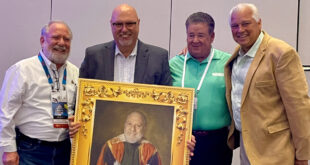While standpipe systems may seem very simple and are often considered an afterthought in the overall design of a fire protection system, they are critical components that can result in the loss of life if not designed and installed properly.
Standpipe systems are installed to help response personnel deploy hose lines quickly while providing adequate water pressure and volume. They provide 21/2-in. connections for heavy stream use by fire departments, 11/2-in. connections for use by trained personnel during the initial response, or both.
Moving a heavy fire hose up through a building takes time, and time costs lives in a fire emergency. Having fixed hose connections in place allows firefighters to quickly carry empty hoses to each stairwell. This keeps stairways clear and makes it safer for exiting occupants. The use of standpipes also reduces friction losses due to hose length or kinking.
Standpipe systems must be designed and installed per NFPA 14, Standard for the Installation of Standpipe and Hose Systems. The Engineer of Record and designer must have detailed discussions with the responding fire department and all other Authorities Having Jurisdiction (AHJs) on what they need from the standpipe system. NFPA 14 makes this point clearly in Section 5.1.2:
The AHJ shall be consulted regarding the required type of system, class of system, and special requirements.
The annex provides additional details:
The need for a standpipe system and some design elements will normally come from the jurisdiction’s adopted building code and fire prevention code. Design of standpipe systems should include consideration of local fire department suppression tactics, hose size, hose length, and types of nozzles used.
These discussions must be documented to protect all parties. The design requirements for the specific project must be clearly detailed on the shop drawings. This will enable all involved in the installation, commissioning, and ITM (inspection, testing, and maintenance) activities to understand the system performance requirements.
What happens when this coordination and agreement does not occur? It may result in system failure and loss of life.
One example of a standpipe failure is the fire that occurred at One Meridian Plaza in Philadelphia, Pennsylvania, on February 23, 1991. It began on the 22nd floor and raged out of control for 19 hours. Philadelphia firefighters valiantly fought the blaze but struggled due to a lack of power in the skyscraper and insufficient water pressure from the building standpipes. Three firefighters died after becoming disoriented by heavy smoke. The fire was only brought under control once it reached the 30th floor, which was one of the few floors with sprinklers installed. In the end, this 12-alarm fire was controlled by only 10 sprinklers.
A report issued by the Federal Emergency Management Agency, TR-049, High-Rise Office Building Fire, One Meridian Plaza, detailed the fire cause, response, and failures. The following deficiencies were identified for the standpipe system:
Improperly installed standpipe valves provided inadequate pressure for fire department hose streams using 13/4-in. hose and automatic fog nozzles. Pressure reducing valves were installed to limit standpipe outlet discharge pressures to safe levels. The PRVs were set too low to produce effective hose streams; tools and expertise to adjust the valve settings did not become available until too late.
When this building was constructed in 1972, the minimum residual pressure was 65 psi at the most remote outlet. This fire demonstrated that this pressure is inadequate for supporting modern firefighting equipment. It was changed to 100 psi in the 1993 edition of NFPA 14. This fire also emphasized the importance of proper inspection and testing that would have revealed the problem with the PRV settings. NFPA 25, Standard for the Inspection, Testing, and Maintenance of Water-Based Fire Protection Systems, was created in 1992 to address these issues.
A memorial was unveiled on October 21, 2009, honoring the three firefighters who died in the fire: Captain David Holcombe, Firefighter Phillis McAllister, and Firefighter James Chappell. As fire protection system professionals, we have a duty to remember their sacrifice and do whatever we can to prevent future incidents
 ABOUT THE AUTHOR: John August Denhardt, P.E., ET, CWBSP, FSFPE, is the vice president of engineering and technical services for the American Fire Sprinkler Association (AFSA). He is responsible for strengthening AFSA’s engineering and technical approaches to meeting member, industry, and operational priorities, with an emphasis on service, quality, and integrity. Denhardt is a registered professional engineer (P.E.) in the District of Columbia and the states of Delaware, Maryland, Pennsylvania, and Virginia. He is NICET Level III certified in water-based systems layout, NICET Level III certified in inspection and testing of water-based systems, and a certified water-based system professional through NFPA. Denhardt is a member of the NFPA 13 technical committee on sprinkler system discharge criteria, a fellow in the Society of Fire Protection Engineers (SFPE), a member of the SFPE Board of Directors, a member of the Board of Trustees for NFPA’s Fire Protection Research Foundation and sits on the University of Maryland Department of Fire Protection Engineering’s Board of Visitors. A native of Maryland, Denhardt holds a Bachelor of Science degree from the University of Maryland College Park in fire protection engineering. Prior to this role, Denhardt was employed by Strickland Fire Protection in Forestville, Maryland, since 1994, overseeing large-scale projects and assisting with design and installation technical issues.
ABOUT THE AUTHOR: John August Denhardt, P.E., ET, CWBSP, FSFPE, is the vice president of engineering and technical services for the American Fire Sprinkler Association (AFSA). He is responsible for strengthening AFSA’s engineering and technical approaches to meeting member, industry, and operational priorities, with an emphasis on service, quality, and integrity. Denhardt is a registered professional engineer (P.E.) in the District of Columbia and the states of Delaware, Maryland, Pennsylvania, and Virginia. He is NICET Level III certified in water-based systems layout, NICET Level III certified in inspection and testing of water-based systems, and a certified water-based system professional through NFPA. Denhardt is a member of the NFPA 13 technical committee on sprinkler system discharge criteria, a fellow in the Society of Fire Protection Engineers (SFPE), a member of the SFPE Board of Directors, a member of the Board of Trustees for NFPA’s Fire Protection Research Foundation and sits on the University of Maryland Department of Fire Protection Engineering’s Board of Visitors. A native of Maryland, Denhardt holds a Bachelor of Science degree from the University of Maryland College Park in fire protection engineering. Prior to this role, Denhardt was employed by Strickland Fire Protection in Forestville, Maryland, since 1994, overseeing large-scale projects and assisting with design and installation technical issues.

 Sprinkler Age A Publication of the American Fire Sprinkler Association
Sprinkler Age A Publication of the American Fire Sprinkler Association
